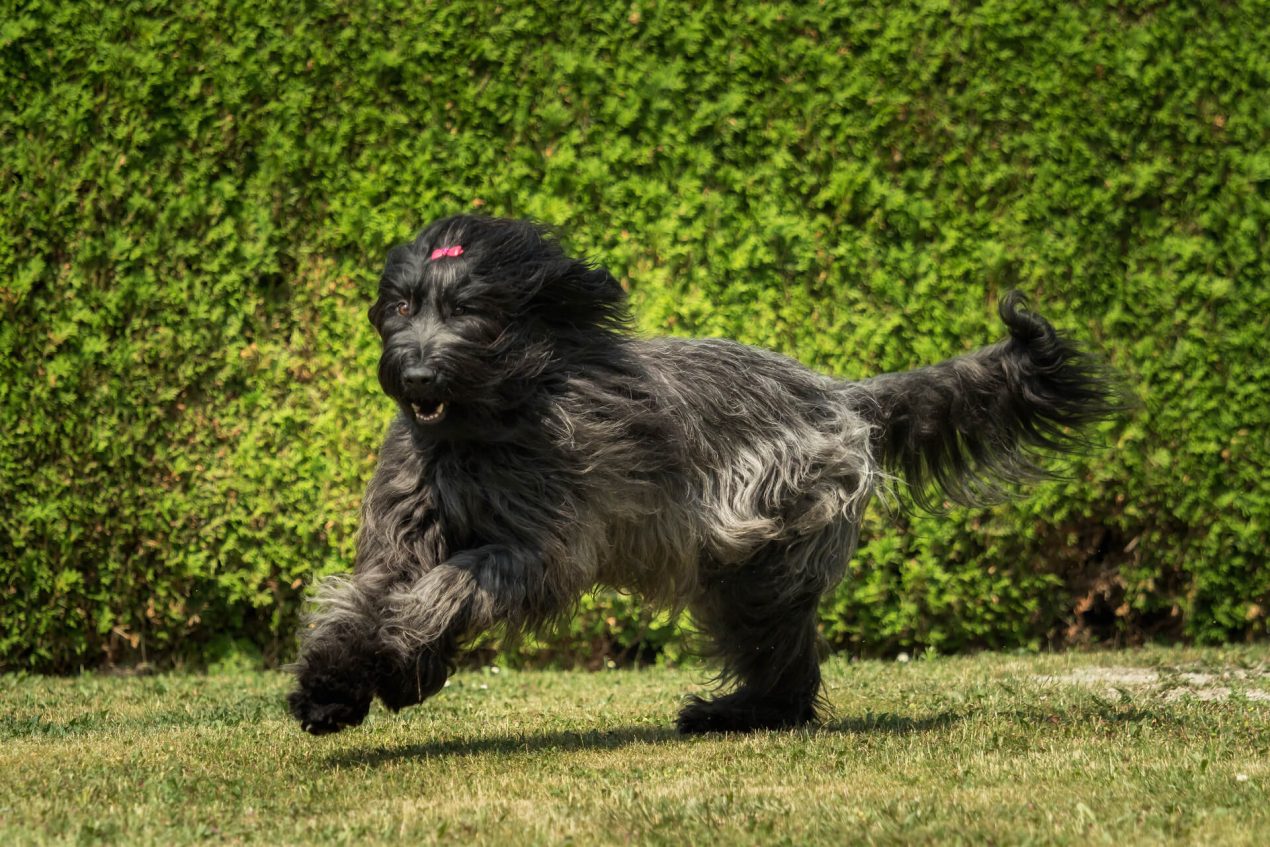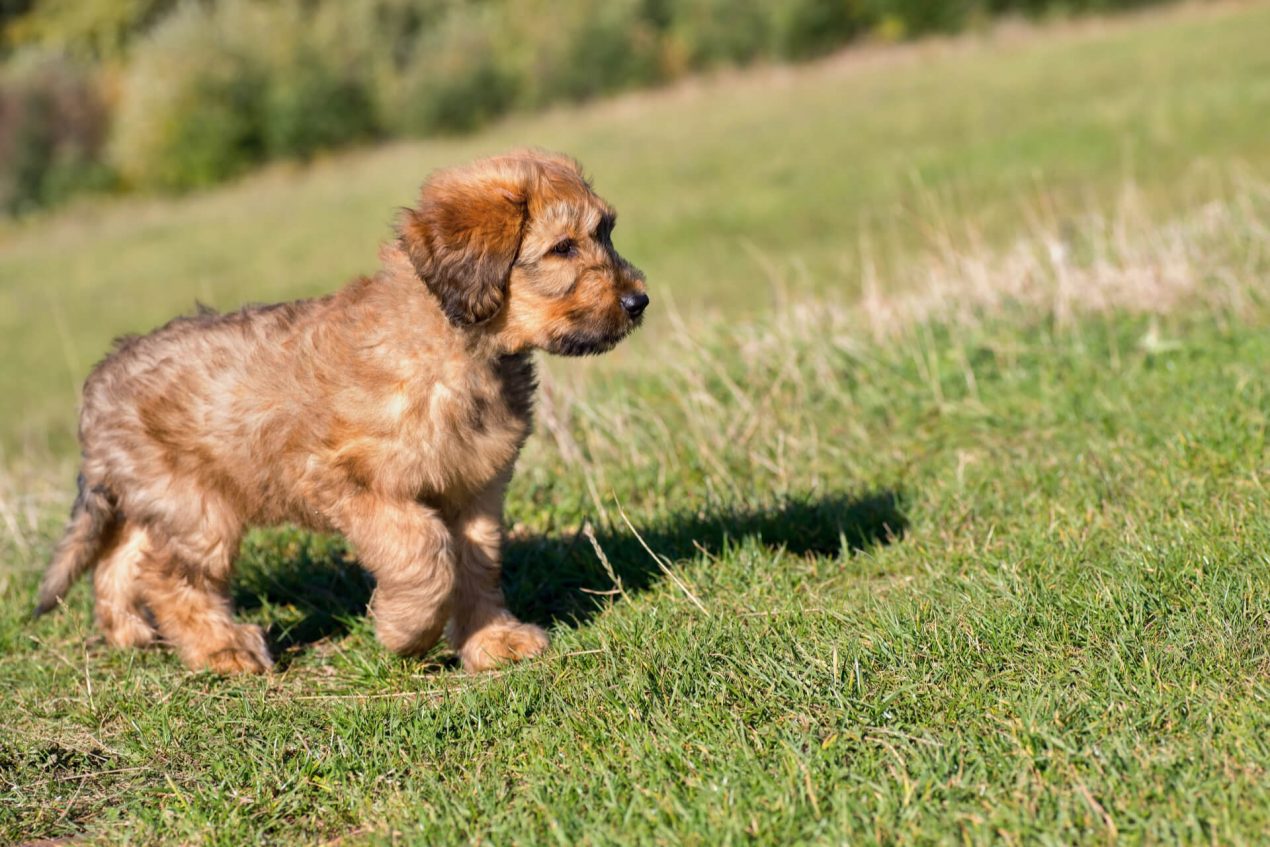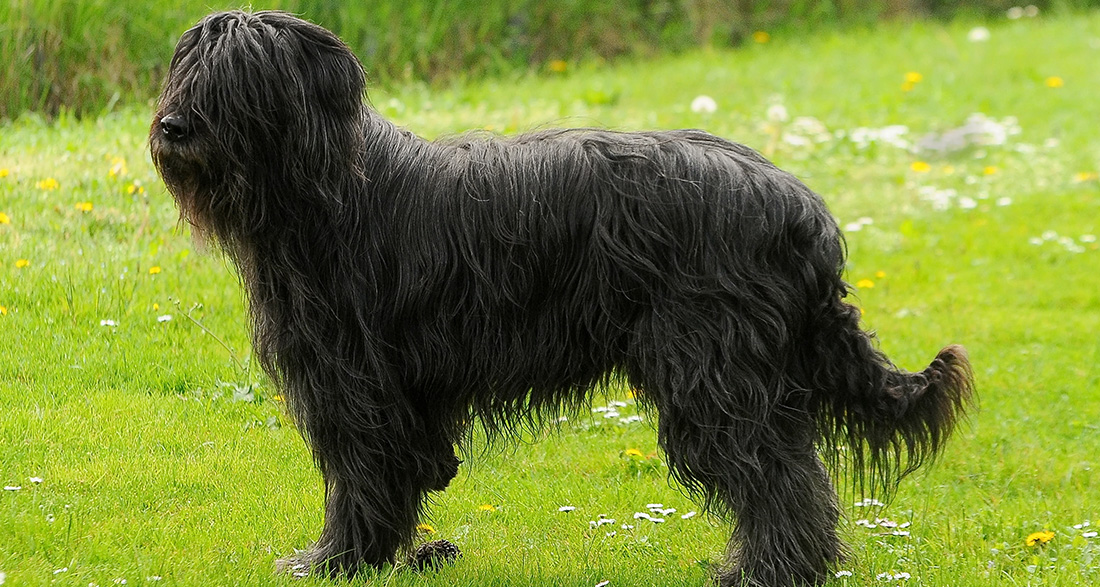The Berger de Brie, better known as Briard, is a lively herding dog originally from France. In this profile, you will find information about the history, temperament, and care of this active dog breed.
Origin & History
Where does the Briard originally come from?
“Berger de Brie” refers to a shepherd dog from the Brie region. Brie is a landscape in the heart of France, known for the famous soft cheese of the same name. Here, Brie generally denotes lowland. Therefore, the Briard is the dog of shepherds in the lowlands of France, assisting in the care of sheep and cattle herds. Written records that could refer to this dog date back to 1387.
In 1809, Abbe Rozier first used the term “Berger de Brie.” The Briard is thus one of the historically longest and most accurately documented dog breeds, excluding hunting dogs. It is a classic shepherd dog that can also be used in various roles. During the World Wars, it served as a guard and messenger dog, as well as for searching for the injured on the battlefields.
The term “Berger de Brie” was first used in 1809. The official recognition of the breed took place in 1896. These versatile dogs served as guard and messenger dogs in the World Wars and continue to work as police and search and rescue dogs today. However, they are now mainly kept as family or companion dogs. They belong to FCI Group 1, “Sheepdogs and Cattledogs,” Section 1, “Sheepdogs.”
Breed Overview
GROUP: Herding
HEIGHT: 23 to 27 inches (males); 22 to 25.5 inches (females)
WEIGHT: 55 to 100 pounds
TEMPERAMENT: Loyal, affectionate, intelligent, companionable, active
COAT: Double coat with wiry, wavy outercoat and soft undercoat
COAT COLOR: Solid black, gray, tawny, white, or combinations of two colors
HYPOALLERGENIC: No
LIFE SPAN: 10 to 12 years
Temperament and Character
The Briard is an affectionate and intelligent family dog. Patient, fond of children, and possessing a strong protective instinct, the Briard can become playful and exuberant during activities. As a former herding dog, it has a lovable tendency to ensure that its human family stays together. These spirited dogs prefer not to be left alone and benefit from early training for short separations. They are adaptable and, with proper training, can accompany their owners anywhere. Briards are cautious but friendly towards strangers. They get along well with other dogs and household pets, displaying a mild disposition and lacking a strong prey drive, focusing more on their family.
| Affection Level | High |
| Friendliness | High |
| Kid-Friendly | High |
| Pet-Friendly | High |
| Exercise Needs | Medium |
| Playfulness | Medium |
| Energy Level | Medium |
| Trainability | Medium |
| Intelligence | High |
| Tendency to Bark | Medium |
| Amount of Shedding | Low |
What does a Briard look like?
The Briard is a medium to large-sized dog that immediately catches the eye with its lush, long coat. The fur is supposed to be very long and twisted all over the body, including the head. The hair should be dry like goat hair, and the Briard has little undercoat. The long coat is an ancient, typical characteristic of this herding dog, which once protected him during work in all weather conditions and to some extent against wolf bites. Today’s breeding practices often tend to exaggerate, particularly focusing on the length and texture of the coat when assessing the quality of these strong-willed dogs.
Excessive growth around the head can hinder their vision and even lead to eye injuries. Although the official FCI and AKC standard states that the eyes should only be “slightly covered,” it is not uncommon to see breeding dogs enduring a veritable hair curtain in front of their eyes. Acceptable coat colors include black, fawn, fawn overlaid with black, gray, or blue, often with a mask. Otherwise, the standard describes them as “a rustic dog, supple, muscular, and well-proportioned; lively and alert.” A special feature of the Berger de Brie are the double dewclaws, also known as wolf claws.
Most dogs have a single dewclaw, which is the degenerate large toe located above the paw with no ground contact or function. “Single dewclaw or entirely missing dewclaws on the hind limbs” are considered breeding disqualifications, although the absence of dewclaws could be advantageous for the fitness and health of the dogs. A Briard has a life expectancy of around 12 years, and it is not uncommon to find individuals that remain in excellent health for much longer.

Are there breed-specific diseases in the Briard?
The Briard is a relatively healthy dog breed, as long as it is not excessively bred for certain external features such as coat length. The standard dictates that the eyes should only be “lightly covered” by the head hair. Unfortunately, it is common to see dogs whose eyes are practically covered by abundant hair, which is against animal welfare. The same applies to a double dewclaw. Additionally, a specific form of congenital eye defect, known as congenital stationary night blindness (CSNB), is prevalent in the Briard. There is also a predisposition to faulty ureters. The breeding associations in the AKC (American Kennel Club) only allow dogs for breeding that are free of these genetic defects.
What is the best food for a Briard?
A Briard eats relatively little for a dog of its size. As with most larger dog breeds, one must be cautious about preventing gastric torsion. The Briard is suitable for a raw food diet (BARF) if done professionally.
Activities with the Briard
How much exercise does a Briard need?
A Briard is suitable for almost all activities you can undertake with a dog. He enjoys activities that match his nature, preferably herding work. Since he rarely finds herding work today, he is open to various types of physical activity. Briards can be found participating in agility and most other dog sports. They also excel as search and rescue dogs and therapy dogs, as well as in protection dog sports, regularly showcasing their intelligence and work ethic.

Health and Grooming
The Briard’s long coat requires regular grooming. During shedding, use a soft wire brush or natural hair brush. While Briards shed minimally, the undercoat tends to mat and needs to be removed. Without proper care, the coat can become matted and emit an unpleasant odor. Use scissors only in emergencies, and pay attention to combing the hair around the paws, behind the ears, and on the chest. Trim or tie up the hair if it covers the eyes. Baths should be infrequent. Health-wise, herding dogs are generally robust. However, be cautious about excessive stair climbing during the puppy stage. Briards reach physical maturity at ten to twelve months and have a lifespan of approximately 10 to 12 years. To ensure a long and healthy life, provide the dog with high-quality, meat-based dog food.
Is the Briard Right for Me?
The Briard is a gentle yet lively dog. He desires integration into the family and, with proper training, can behave impeccably within it. Ideally, a house with a garden in the countryside is suitable for him. Keeping him in a small apartment in the heart of a big city may not be recommended. When traveling by car, he is best transported in a professional travel crate.
The Briard is highly trainable. He is open, honest, and enjoys working with his owners. The challenge lies in finding the right balance of consistency and firmness for this very spirited, hardworking, yet sensitive dog. The crucial foundation is always a close emotional and trusting mutual bond. Ideally, after basic training, one should consider further education with the Berger de Brie. Various dog sports and training programs for therapy, protection, or search and rescue dogs are well-suited for this purpose.

For those interested in a puppy, contact a breeder affiliated with the AKC (American Kennel Club). As the breed is relatively rare in the United States, getting a puppy may not be immediate. Seek guidance from the breeder before making a purchase and avoid buying a puppy priced below $800. Expect to pay at least $1000. Those interested in a dog from a shelter can also contact the Briard Club. Representations of the breed or mixes are occasionally available for adoption.
Interesting Facts
Due to its lovable and cheerful nature, the Briard has become a star in film and television. Since the 1960s, the breed has played roles in numerous films. For example, the male Briard named “Michael” portrayed the family dog “Buck” in the series “Married… with Children.” In the film “Kiss Kiss Bang Bang” with Robert Downey Jr., a Briard is also featured.
The German millionaire family of Robert and Carmen Geiss owns a male named Dex, appearing in many episodes of the reality series “Die Geissens – Eine schrecklich glamouröse Familie.” A particularly famous Berger de Brie, known for his unique skills, is “Norman the Scooter Dog.” His owners taught him to ride scooters and bicycles, showcasing his talents in various videos.
Do you own a Briard or are you considering getting one? Share your thoughts in the comments on what makes this breed special to you!


